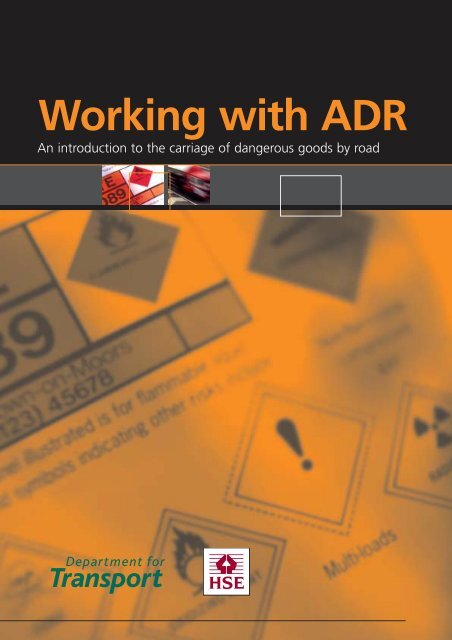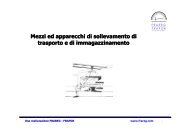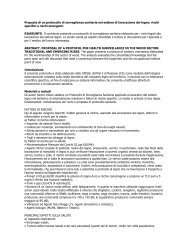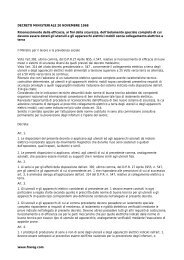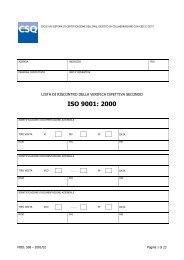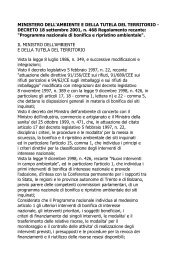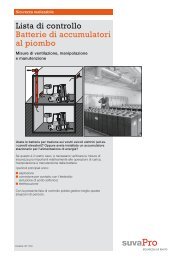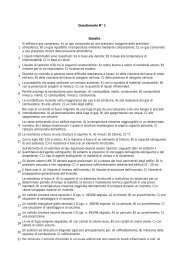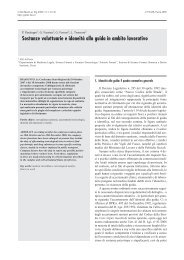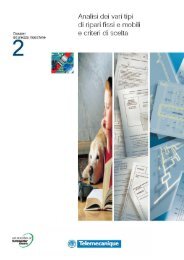Working with ADR - An introduction to the carriage of ... - everysite
Working with ADR - An introduction to the carriage of ... - everysite
Working with ADR - An introduction to the carriage of ... - everysite
Create successful ePaper yourself
Turn your PDF publications into a flip-book with our unique Google optimized e-Paper software.
<strong>Working</strong> <strong>with</strong> <strong>ADR</strong><br />
<strong>An</strong> <strong>introduction</strong> <strong>to</strong> <strong>the</strong> <strong>carriage</strong> <strong>of</strong> dangerous goods by road
INTRODUCTION<br />
Dangerous goods, such as explosives, flammables or corrosives, have inherent hazards. There is a risk<br />
that incidents involving <strong>the</strong>se hazards may cause harm <strong>to</strong> people, property and <strong>the</strong> environment, eg by<br />
explosion, fire or spillage.<br />
Great Britain (GB) legislation on <strong>the</strong> <strong>carriage</strong> <strong>of</strong> dangerous goods has gradually converged <strong>with</strong><br />
international legislation. Both aim <strong>to</strong> regulate in such a way that risks are reduced as far as possible<br />
and incidents can be safely and effectively dealt <strong>with</strong>, but commerce is not impeded.<br />
Responsibility for <strong>the</strong> preparation <strong>of</strong> future GB legislation on <strong>the</strong> transport <strong>of</strong> dangerous goods by road<br />
and rail is transferring from HSE <strong>to</strong> <strong>the</strong> Department for Transport (DfT) in time for DfT <strong>to</strong> draft<br />
Regulations implementing <strong>the</strong> 2005 amending Commission Directives. These Regulations have <strong>to</strong> be in<br />
place by 1 July 2005.<br />
Changes<br />
The Carriage <strong>of</strong> Dangerous Goods and Use <strong>of</strong> Transportable Pressure Equipment Regulations 2004 1 (<strong>the</strong><br />
Carriage Regulations) apply <strong>to</strong> <strong>the</strong> <strong>carriage</strong> <strong>of</strong> dangerous goods by road and rail. They place general<br />
duties on everyone <strong>with</strong> a role in <strong>the</strong> <strong>carriage</strong> <strong>of</strong> dangerous goods, and specific duties on those in <strong>the</strong><br />
transport chain, ie consignors, carriers, loaders, packers, etc.<br />
The Carriage Regulations refer <strong>to</strong> <strong>the</strong> European Agreement concerning <strong>the</strong> International Carriage <strong>of</strong><br />
Dangerous Goods by Road 2003 2 (<strong>ADR</strong> 2003) and Regulations concerning <strong>the</strong> International Carriage <strong>of</strong><br />
Dangerous Goods by Rail 2003 3 (RID 2003). The Regulations also implement a fur<strong>the</strong>r Directive on<br />
transportable pressure equipment. 4 They replace, by a single Statu<strong>to</strong>ry Instrument (SI), 12 previous SIs<br />
that regulated <strong>the</strong> <strong>carriage</strong> <strong>of</strong> dangerous goods by road and rail in GB. 5<br />
This leaflet covers <strong>the</strong> <strong>carriage</strong> <strong>of</strong> dangerous goods by road. It is not intended <strong>to</strong> serve as a summary <strong>of</strong><br />
ei<strong>the</strong>r <strong>the</strong> Carriage Regulations or <strong>ADR</strong>, but as a ‘route map’ <strong>to</strong> help you determine whe<strong>the</strong>r any<br />
<strong>carriage</strong> might fall <strong>with</strong>in <strong>the</strong> scope <strong>of</strong> <strong>the</strong> Regulations and <strong>ADR</strong>, and guide you through working <strong>with</strong><br />
both documents <strong>to</strong> determine <strong>the</strong> requirements that apply <strong>to</strong> you.<br />
This leaflet does not cover <strong>carriage</strong> <strong>of</strong> dangerous goods by rail or by inland waterways. It does not deal<br />
<strong>with</strong> <strong>carriage</strong> <strong>of</strong> radioactive materials or transportable pressure equipment in detail - <strong>the</strong>se will be<br />
covered elsewhere.<br />
At <strong>the</strong> start <strong>of</strong> each section, <strong>the</strong>re is a summary setting out <strong>the</strong> <strong>to</strong>pic, relevant regulation <strong>of</strong> <strong>the</strong><br />
3
Carriage Regulations and section <strong>of</strong> <strong>ADR</strong> 2003 and which duty holder(s) it applies <strong>to</strong>.<br />
<strong>An</strong>yone involved in <strong>the</strong> <strong>carriage</strong> <strong>of</strong> dangerous goods must refer <strong>to</strong> <strong>ADR</strong> 2003 <strong>to</strong> understand its<br />
requirements and be able <strong>to</strong> comply <strong>with</strong> <strong>the</strong>m.<br />
<strong>ADR</strong> 2003<br />
<strong>ADR</strong> 2003 sets out <strong>the</strong> conditions under which dangerous goods can be carried by road, <strong>with</strong> detailed<br />
requirements spelt out in two regularly amended and updated <strong>An</strong>nexes.<br />
There are nine parts <strong>to</strong> <strong>the</strong> <strong>An</strong>nexes. <strong>An</strong>nex A consists <strong>of</strong> Parts 1 <strong>to</strong> 7, and <strong>An</strong>nex B <strong>of</strong> Parts 8 and 9.<br />
Each Part is subdivided in<strong>to</strong> Chapters and each Chapter in<strong>to</strong> sections and sub-sections. For example:<br />
Part 4, Chapter 2, Section 1 is numbered ‘4.2.1’.<br />
Table 1: Contents <strong>of</strong> <strong>ADR</strong><br />
1 General provisions<br />
2 Classification<br />
3 Dangerous Goods List; special provisions and exemptions related <strong>to</strong> dangerous goods packed in<br />
limited quantities<br />
4 Packaging and tank provisions<br />
5 Consignment procedures<br />
6 Construction and testing <strong>of</strong> packagings, intermediate bulk containers (IBCs), large packagings and tanks<br />
7 Conditions <strong>of</strong> <strong>carriage</strong>, loading, unloading and handling<br />
8 Vehicle crews, equipment, operation and documentation<br />
9 Construction and approval <strong>of</strong> vehicles<br />
Part 1 defines terms used in both <strong>An</strong>nexes, spells out <strong>ADR</strong>’s scope and applicability, and Part 2 places<br />
general safety obligations, <strong>to</strong> be supported by checks and o<strong>the</strong>r measures, on participants in <strong>the</strong><br />
transport chain, eg training and appointment <strong>of</strong> safety advisers.<br />
Table A, Chapter 3.2 (see ‘The Dangerous Goods List’) is key <strong>to</strong> <strong>the</strong> use <strong>of</strong> <strong>ADR</strong>.<br />
General and specific definitions appear in <strong>ADR</strong> 1.2 (‘Definitions and units <strong>of</strong> measurement’). Fur<strong>the</strong>r<br />
specific terms are defined elsewhere throughout <strong>ADR</strong>.<br />
4
The Carriage Regulations<br />
The Carriage Regulations implement <strong>ADR</strong> (<strong>with</strong> a number <strong>of</strong> exceptions). They refer directly <strong>to</strong> <strong>ADR</strong><br />
and <strong>the</strong>re are some additional or alternative requirements <strong>to</strong> <strong>ADR</strong>. You will generally need <strong>to</strong> be aware<br />
only <strong>of</strong> Parts 1 (except regulation 8), 2, 5 and 6 and Schedule 9 <strong>of</strong> <strong>the</strong> Carriage Regulations, unless<br />
you need <strong>to</strong>:<br />
■ understand competent authority (CA) functions in detail; or<br />
■ be involved in <strong>the</strong> construction/conformity assessment or re-assessment/periodic inspection/repeated<br />
use at work <strong>of</strong> transportable pressure equipment (TPE).<br />
EXEMPTIONS<br />
Exemptions and application Regulations 3-7 <strong>ADR</strong> 1.1.3-1.1.4<br />
All<br />
Throughout this guide, ‘exemptions’ is used <strong>to</strong> mean both <strong>to</strong>tal exemption from all or some <strong>of</strong> <strong>the</strong><br />
requirements <strong>of</strong> <strong>ADR</strong> or <strong>the</strong> Regulations, and partial exemptions or ‘relaxations’.<br />
<strong>ADR</strong> contains exemptions for <strong>the</strong> <strong>carriage</strong> <strong>of</strong> packaged dangerous goods where certain conditions<br />
apply, but <strong>the</strong>se exemptions do not apply <strong>to</strong> <strong>the</strong> <strong>carriage</strong> <strong>of</strong> dangerous goods by road in tanks<br />
or in bulk.<br />
Exemptions related <strong>to</strong> <strong>the</strong> nature <strong>of</strong> <strong>the</strong> transport operation<br />
Subject <strong>to</strong> certain conditions and qualifications, <strong>the</strong> requirements <strong>of</strong> <strong>ADR</strong> do not apply <strong>to</strong>:<br />
■ <strong>carriage</strong> <strong>of</strong> dangerous goods by private individuals where <strong>the</strong> goods are packaged for retail sale and<br />
are intended for <strong>the</strong>ir personal or domestic use or for <strong>the</strong>ir leisure or sporting activities;<br />
■ <strong>carriage</strong> <strong>of</strong> machinery or equipment not specifically listed in <strong>the</strong> Dangerous Goods List and which<br />
contain dangerous goods in <strong>the</strong>ir internal or operational equipment;<br />
■ <strong>carriage</strong> undertaken by enterprises which is ancillary <strong>to</strong> <strong>the</strong>ir main activity;<br />
■ <strong>carriage</strong> undertaken by, or under <strong>the</strong> supervision <strong>of</strong>, <strong>the</strong> emergency services, in particular by<br />
breakdown vehicles carrying vehicles which have been involved in accidents or have broken down<br />
and contain dangerous goods;<br />
■ emergency transport intended <strong>to</strong> save human lives or protect <strong>the</strong> environment.<br />
Exemptions related <strong>to</strong> special provisions<br />
Certain special provisions <strong>of</strong> <strong>ADR</strong> 3.3 exempt partially or <strong>to</strong>tally <strong>the</strong> <strong>carriage</strong> <strong>of</strong> specific dangerous<br />
5
goods from <strong>the</strong> requirements <strong>of</strong> <strong>ADR</strong>. The exemption applies when a relevant special provision appears<br />
in column 6 <strong>of</strong> <strong>the</strong> Dangerous Goods List against <strong>the</strong> appropriate entry for that article or substance.<br />
Exemptions related <strong>to</strong> dangerous goods packed in limited quantities<br />
If a ‘limited quantity’ code LQ1-LQ29 (<strong>ADR</strong> 3.4) appears in column 7 <strong>of</strong> <strong>the</strong> appropriate entry <strong>of</strong> <strong>the</strong><br />
Dangerous Goods List, <strong>the</strong>n that article or substance is exempted from <strong>the</strong> requirements <strong>of</strong> <strong>ADR</strong>, but only if:<br />
■ it meets packaging and marking requirements; and<br />
■ <strong>the</strong> prescribed maximum quantities per inner packaging, and per package, are not exceeded<br />
(Table, <strong>ADR</strong> 3.4.6).<br />
When <strong>the</strong> code LQ0 appears in column 7 <strong>of</strong> <strong>the</strong> Dangerous Goods List, <strong>the</strong> substance or article is not<br />
exempted from any requirements <strong>of</strong> <strong>ADR</strong> (unless o<strong>the</strong>rwise specified).<br />
Exemptions related <strong>to</strong> quantities carried per transport unit<br />
This class <strong>of</strong> exemptions is sometimes also loosely referred <strong>to</strong> as ‘limited quantities’, but should not be<br />
confused <strong>with</strong> those described above.<br />
<strong>ADR</strong> 1.1.3.6 assigns dangerous goods <strong>to</strong> a transport category, which appears in column 15 <strong>of</strong> <strong>the</strong><br />
Dangerous Goods List. This exemption applies ei<strong>the</strong>r:<br />
(a) where <strong>the</strong> dangerous goods carried in <strong>the</strong> transport unit are all in one transport category and <strong>the</strong><br />
quantity carried does not exceed <strong>the</strong> value in column 3 <strong>of</strong> <strong>the</strong> table in <strong>ADR</strong> 1.1.3.6, as modified by<br />
regulation 3(7)(b) <strong>of</strong> <strong>the</strong> Carriage Regulations:<br />
Transport category<br />
Max <strong>to</strong>tal quantity per transport unit*<br />
0 0<br />
1 20<br />
1A 50<br />
2 333<br />
2A 500<br />
3 1000<br />
4 unlimited<br />
*For articles, gross mass in kg (for articles <strong>of</strong> Class 1, net mass in kg <strong>of</strong> <strong>the</strong> explosive substance); for<br />
solids, liquefied gases, refrigerated liquefied gases and dissolved gases, net mass in kg; for liquids and<br />
compressed gases, nominal capacity <strong>of</strong> receptacles (see definition in <strong>ADR</strong> 1.2.1) in litres.<br />
6
or<br />
(b) where <strong>the</strong> dangerous goods carried in <strong>the</strong> transport unit are in more than one transport category<br />
and <strong>the</strong> <strong>to</strong>tal quantity carried does not exceed <strong>the</strong> value calculated in accordance <strong>with</strong> <strong>ADR</strong> 1.1.3.6.4.<br />
If ei<strong>the</strong>r <strong>of</strong> <strong>the</strong>se conditions applies, <strong>the</strong> dangerous goods may be carried in packages on a single<br />
transport unit, and <strong>the</strong> following requirements <strong>of</strong> <strong>ADR</strong> will not apply:<br />
O<strong>the</strong>r exemptions<br />
<strong>ADR</strong><br />
Covering<br />
5.3 Placarding and marking <strong>of</strong> containers etc<br />
5.4.3 Documentation - instructions in writing<br />
7.2, except for V5, V7 and V8 <strong>of</strong> 7.2.4 Carriage in packages<br />
CV1 <strong>of</strong> 7.5.11<br />
Part 8, except for 8.1.4.2-8.1.4.5, 8.2.3,<br />
8.3.4,8.4, and S1(3), S1(6), S2(1), S4 ,<br />
S14-S21 <strong>of</strong> 8.5<br />
Part 9<br />
Prohibitions on loading and unloading in public places<br />
Vehicle crews, equipment, operation and documentation<br />
Construction and approval <strong>of</strong> vehicles<br />
<strong>ADR</strong> also includes exemptions relating <strong>to</strong>:<br />
■ <strong>carriage</strong> <strong>of</strong> gases;<br />
■ <strong>carriage</strong> <strong>of</strong> liquid fuels;<br />
■ empty uncleaned packagings;<br />
■ <strong>carriage</strong> in a transport chain including maritime or air <strong>carriage</strong>;<br />
■ use <strong>of</strong> portable tanks approved for maritime transport; and<br />
■ <strong>carriage</strong> o<strong>the</strong>r than by road.<br />
Derogations<br />
There are a number <strong>of</strong> permanent relaxations from <strong>the</strong> EC Directives covering <strong>carriage</strong> <strong>of</strong> dangerous<br />
goods by road. These relaxations, referred <strong>to</strong> as ‘derogations’, were agreed by <strong>the</strong> EC in December<br />
2002 and are reflected in <strong>the</strong> Carriage Regulations.<br />
Derogations applying <strong>to</strong> <strong>the</strong> <strong>carriage</strong> <strong>of</strong> dangerous goods (<strong>with</strong> <strong>the</strong> exception <strong>of</strong> Class 1) are detailed in<br />
‘Derogations o<strong>the</strong>r than Class 1’ (<strong>An</strong>nex 1), and derogations applying only <strong>to</strong> <strong>the</strong> <strong>carriage</strong> <strong>of</strong> Class 1<br />
7
dangerous goods are described under ‘Class 1 derogations’ (<strong>An</strong>nex 2).<br />
CLASSIFICATION OF DANGEROUS GOODS<br />
Classification <strong>of</strong> goods Regulation 15 <strong>ADR</strong> 2.1-2.3 and Dangerous<br />
Goods List<br />
Consignor<br />
Dangerous goods should not be consigned for <strong>carriage</strong> by road unless <strong>the</strong> goods have been classified<br />
in accordance <strong>with</strong>:<br />
■ <strong>the</strong> relevant general requirements <strong>of</strong> <strong>ADR</strong> 2.1;<br />
■ <strong>the</strong> requirement <strong>to</strong> assign UN number, name and description, and packing group (where appropriate)<br />
<strong>to</strong> those goods as indicated in columns 1, 2 and 4 respectively <strong>of</strong> <strong>the</strong> Dangerous Goods List;<br />
■ any relevant class-specific requirements <strong>of</strong> <strong>ADR</strong> 2.2, as indicated in columns 3a and 3b <strong>of</strong> <strong>the</strong><br />
Dangerous Goods List; and<br />
■ <strong>the</strong> relevant test methods as set out in <strong>ADR</strong> 2.2 and 2.3.<br />
Principles <strong>of</strong> classification<br />
Dangerous goods covered by each UN Class are defined on <strong>the</strong> basis <strong>of</strong> <strong>the</strong>ir properties according <strong>to</strong><br />
<strong>ADR</strong> 2.2.x.1, where x indicates <strong>the</strong> UN Class:<br />
Class 1 Explosive substances and articles<br />
Class 2 Gases<br />
Class 3 Flammable liquids<br />
Class 4.1 Flammable solids, self-reactive substances and solid desensitized explosives<br />
Class 4.2 Substances liable <strong>to</strong> spontaneous combustion<br />
Class 4.3 Substances which, in contact <strong>with</strong> water, emit flammable gases<br />
Class 5.1 Oxidizing substances<br />
Class 5.2 Organic peroxides<br />
Class 6.1 Toxic substances<br />
Class 6.2 Infectious substances<br />
Class 7 Radioactive material<br />
Class 8 Corrosive substances<br />
Class 9 Miscellaneous dangerous substances and articles<br />
Once <strong>the</strong> class, subsidiary risk (if any) and packing group (if any) have been established, <strong>the</strong> relevant UN<br />
8
number can be determined.<br />
Articles or substances not listed in <strong>the</strong> Dangerous Goods List or defined in any <strong>of</strong> <strong>the</strong> sub-sections <strong>ADR</strong><br />
2.2.x.2 have <strong>to</strong> be assigned <strong>to</strong> <strong>the</strong> relevant Class according <strong>to</strong> <strong>the</strong> danger(s) <strong>the</strong>y present on <strong>the</strong> basis<br />
<strong>of</strong> <strong>the</strong> criteria mentioned in <strong>ADR</strong> 2.2.x.1, and using appropriate test methods. The danger(s) presented<br />
by an article or substance must be determined on <strong>the</strong> basis <strong>of</strong> its physical or chemical properties.<br />
THE DANGEROUS GOODS LIST<br />
Dangerous Goods List Regulation 17 <strong>ADR</strong> 3.2<br />
and special provisions<br />
All<br />
The Dangerous Goods List is <strong>ADR</strong> Table A, Chapter 3.2, which lists all dangerous goods in UN number<br />
order, and contains relevant information on <strong>the</strong> goods listed, such as name, class, packing group(s),<br />
label(s) <strong>to</strong> be affixed, etc. The entries for each substance or article refer <strong>to</strong> detailed, specific <strong>carriage</strong><br />
requirements (‘special provisions’).<br />
Dangerous Goods List - <strong>to</strong>pics covered, and references<br />
Column Topic Carriage Regulations <strong>ADR</strong><br />
1 UN Number 15<br />
2 Name and description 15 3.1.2<br />
3a Class 15 2.2<br />
3b Classification code 15 2.2<br />
4 Packing group 15 2.1.1.3<br />
5 Labels 20(1), 20(3) 5.2.2<br />
6 Special provisions 3(14), 17(1), 17(4) 3.3<br />
7 Limited quantities 3(15) 3.4.6<br />
9
Packaging:<br />
8 Packing instructions 18 4.1.4<br />
9a Special packing provisions 17(1), 18 4.1.4<br />
9b Mixed packing provisions 18 4.1.10<br />
Tanks:<br />
10 UNPT: Instructions 19(1), 23(3) 4.2.5.2<br />
11 UNPT: Special provisions 17(1), 19(1) 4.2.5.3<br />
12 <strong>ADR</strong>T: Tank code 19(3), 23(3) 4.3<br />
13 <strong>ADR</strong>T: Special provisions 17(1), 19(3) 4.3.5, 6.8.4<br />
14 Vehicle or tank <strong>carriage</strong> 23(4) 9.1.1.2<br />
15 Transport category 3(6), 3(7), 7(1) 1.1.3.6<br />
Transport category:<br />
15 Transport category 3(6), 3(7), 7(1) 1.1.3.6<br />
Special <strong>carriage</strong> provisions:<br />
16 Packages 17(1), 23(1) 7.2.4<br />
17 Bulk 17(1), 23(2) 7.3.3<br />
18 Loading etc 17(1), 23(5) 7.5.11<br />
19 Operation 17(1), 23(10) 8.5<br />
20 Hazard identification 20(3) 5.3.2.3<br />
number<br />
UNPT = UN portable tanks; <strong>ADR</strong>T = <strong>ADR</strong> tank<br />
Table B at 3.2.2 is an alphabetical index giving <strong>the</strong> UN number <strong>of</strong> specific dangerous goods.<br />
10
The following types <strong>of</strong> entries appear in <strong>the</strong> Dangerous Goods List:<br />
■ single entries for well-defined substances or articles including entries for substances covering several<br />
isomers (eg UN 1090, Ace<strong>to</strong>ne); and<br />
■ collective entries, consisting <strong>of</strong>:<br />
- generic entries for well-defined groups <strong>of</strong> substances or articles o<strong>the</strong>r than ‘not o<strong>the</strong>rwise<br />
specified’ (NOS) (eg UN 1133, adhesives),<br />
- specific NOS entries covering a group <strong>of</strong> substances or articles <strong>of</strong> a particular chemical or<br />
technical nature (eg UN 1477, nitrates, inorganic, NOS), and<br />
- general NOS entries covering a group <strong>of</strong> substances or articles having one or more dangerous<br />
properties (eg UN 1993, flammable liquid, NOS).<br />
Points <strong>to</strong> look out for<br />
Care needs <strong>to</strong> be taken when using <strong>the</strong> Dangerous Goods List. For instance, <strong>the</strong>re are occasionally<br />
multiple entries, <strong>with</strong> matching UN number and name. Such entries differ in columns 3a-20, eg <strong>the</strong><br />
entries against UN 1436 differ in packing group and special provisions.<br />
Multiple entries for <strong>the</strong> same UN number sometimes appear, where <strong>the</strong>re are different forms <strong>of</strong> <strong>the</strong><br />
substance, and hence slightly different names. For example, UN 3282 has liquid and solid forms. The<br />
differences are less obvious when looking at, for example, UN 1139 or UN 1263.<br />
There may be more than one UN number for <strong>the</strong> same article or substance, and <strong>the</strong>se may be<br />
consecutive (such as 0248 and 0249 for water-activated explosive contrivances), or not (such as 0102<br />
and 0290 for metal-clad de<strong>to</strong>nating cord). If in doubt, consult ei<strong>the</strong>r <strong>the</strong> alphabetic index <strong>to</strong> <strong>the</strong><br />
Dangerous Goods List, or an electronic version <strong>of</strong> <strong>the</strong> Dangerous Goods List extracted from <strong>the</strong><br />
published CD-Rom and sorted in<strong>to</strong> alphabetical order <strong>of</strong> column 2.<br />
REGULATIONS - GENERAL REQUIREMENTS<br />
Training<br />
Training Regulation 9 <strong>ADR</strong> 1.3, 8.2.3<br />
All<br />
General training<br />
<strong>An</strong>yone involved in <strong>the</strong> <strong>carriage</strong> <strong>of</strong> dangerous goods by road has <strong>to</strong> make sure that <strong>the</strong>y and any <strong>of</strong><br />
<strong>the</strong>ir employees who have any responsibility for such <strong>carriage</strong> are appropriately trained (<strong>ADR</strong> 1.3). This<br />
11
equirement covers, for example, loaders and unloaders, personnel in freight forwarding agencies, and<br />
drivers who do not require specialised driver training (see ‘Driver training’).<br />
The training must include:<br />
■ awareness training, covering <strong>the</strong> general requirements <strong>of</strong> <strong>ADR</strong>;<br />
■ function-specific training, covering <strong>the</strong> detailed requirements <strong>of</strong> <strong>ADR</strong> and (where relevant) o<strong>the</strong>r<br />
modes <strong>of</strong> transport; and<br />
■ safety training, covering <strong>the</strong> hazards and dangers presented by dangerous goods and awareness <strong>of</strong><br />
safe handling and emergency response procedures commensurate <strong>with</strong> <strong>the</strong> degree <strong>of</strong> risk <strong>of</strong> injury<br />
or exposure arising from an incident involving <strong>carriage</strong> <strong>of</strong> dangerous goods.<br />
Details <strong>of</strong> all training should be kept by <strong>the</strong> employer and employee. Training must be verified<br />
when starting a new job, and <strong>the</strong>re should be periodic refresher courses taking account <strong>of</strong> changes<br />
in <strong>the</strong> law.<br />
Driver training<br />
Driver training Regulation 24(1)(a) <strong>ADR</strong> 8.2.1, 8.5*<br />
Carrier<br />
* <strong>An</strong>y relevant requirements <strong>of</strong> <strong>ADR</strong> 8.5 are indicated in column 19 <strong>of</strong> <strong>the</strong> Dangerous Goods List.<br />
<strong>ADR</strong> 8.2 requires drivers <strong>of</strong>:<br />
■ vehicles <strong>with</strong> a permissible maximum mass exceeding 3.5 <strong>to</strong>nnes carrying dangerous goods;<br />
■ tank vehicles; and<br />
■ vehicles carrying Class 1 dangerous goods, or certain Class 7 (radioactive) material<br />
<strong>to</strong> hold a certificate (‘VTC’ or vocational training certificate) issued by <strong>the</strong> Department for Transport<br />
stating that <strong>the</strong>y have attended appropriate training courses and passed an examination on <strong>the</strong><br />
requirements <strong>to</strong> be met during <strong>carriage</strong> <strong>of</strong> dangerous goods.<br />
The main objectives <strong>of</strong> training (which must include <strong>the</strong>oretical courses, individual practical exercises<br />
and appropriate refresher and specialist training) are <strong>to</strong>:<br />
■ make drivers aware <strong>of</strong> hazards arising in <strong>the</strong> <strong>carriage</strong> <strong>of</strong> dangerous goods;<br />
■ give <strong>the</strong>m basic information <strong>to</strong> minimise <strong>the</strong> likelihood <strong>of</strong> an incident taking place; and<br />
■ enable <strong>the</strong>m <strong>to</strong> take necessary measures for <strong>the</strong>ir own safety and that <strong>of</strong> <strong>the</strong> public and <strong>the</strong><br />
environment, <strong>to</strong> limit <strong>the</strong> effects if an incident does occur.<br />
12
Drivers <strong>of</strong> vehicles carrying dangerous goods must, on request, produce <strong>the</strong>ir VTC <strong>to</strong> <strong>the</strong> police or any<br />
goods vehicle examiner.<br />
Drivers not requiring a VTC are still covered by <strong>the</strong> general training requirements <strong>of</strong> <strong>ADR</strong> 1.3 (see<br />
‘General training’).<br />
Safety obligations<br />
Safety obligations Regulation 10 <strong>ADR</strong> 1.4<br />
All; specific duties on: carrier, consignee, consignor, filler, loader, opera<strong>to</strong>r, packer<br />
<strong>ADR</strong> 1.4 requires that anyone involved in <strong>the</strong> <strong>carriage</strong> <strong>of</strong> dangerous goods by road must:<br />
■ act <strong>to</strong> avoid damage/injury from, and minimise <strong>the</strong> effects <strong>of</strong>, foreseeable dangers; and<br />
■ when <strong>the</strong>re is an immediate risk <strong>to</strong> public safety, notify <strong>the</strong> emergency services and give <strong>the</strong>m <strong>the</strong><br />
necessary information.<br />
When dangerous goods are being consigned for a third party, <strong>the</strong> third party has <strong>to</strong> inform <strong>the</strong><br />
consignor in writing that <strong>the</strong> goods are dangerous and make available all <strong>the</strong> necessary information<br />
and documentation.<br />
<strong>ADR</strong> 1.4 places specific duties on three principal classes <strong>of</strong> duty holder:<br />
■ consignors (<strong>ADR</strong> 1.4.2.1);<br />
■ carriers (<strong>ADR</strong> 1.4.2.2); and<br />
■ consignees (<strong>ADR</strong> 1.4.2.3);<br />
as well as o<strong>the</strong>r participants (<strong>ADR</strong> 1.4.3), including (but not limited <strong>to</strong>) loaders, packers, fillers and<br />
opera<strong>to</strong>rs <strong>of</strong> tank containers and portable tanks.<br />
<strong>ADR</strong> 1.4 identifies certain instances where <strong>the</strong> relevant duty holder does not personally have <strong>to</strong> carry<br />
out <strong>the</strong> required actions, but can rely on information provided by o<strong>the</strong>r participants in <strong>the</strong> <strong>carriage</strong> <strong>of</strong><br />
dangerous goods.<br />
REGULATIONS - SPECIFIC REQUIREMENTS<br />
Appoint a safety adviser<br />
Appoint a DGSA Regulation 12 <strong>ADR</strong> 1.8.3.1, 1.8.3.3-1.8.3.9<br />
Carrier, filler, loader<br />
13
<strong>ADR</strong> 1.8.3 requires every organisation whose activities include <strong>the</strong> <strong>carriage</strong> <strong>of</strong> dangerous goods by<br />
road, and related loading (but not unloading), or filling, <strong>to</strong> appoint one or more dangerous goods<br />
safety advisers (DGSAs). Their overall duty is <strong>to</strong> make sure that <strong>carriage</strong> <strong>of</strong> dangerous goods and related<br />
activities are conducted in accordance <strong>with</strong> requirements and in <strong>the</strong> safest possible way. They advise<br />
on, and ensure compliance <strong>with</strong> <strong>ADR</strong> requirements for:<br />
■ identification <strong>of</strong> dangerous goods;<br />
■ equipment used in connection <strong>with</strong> <strong>carriage</strong> and loading;<br />
■ training <strong>of</strong> employees and maintenance <strong>of</strong> training records; and<br />
■ emergency procedures <strong>to</strong> be taken in <strong>the</strong> event <strong>of</strong> any accident or incident that may affect safety.<br />
DGSAs are also responsible for preparing for management an annual report on relevant aspects <strong>of</strong><br />
<strong>the</strong> <strong>carriage</strong> <strong>of</strong> dangerous goods by <strong>the</strong> organisation, and for ensuring that an accident report is<br />
prepared whenever an incident involving <strong>the</strong> <strong>carriage</strong> <strong>of</strong> dangerous goods affects people, property<br />
or <strong>the</strong> environment.<br />
DGSAs have <strong>to</strong> be capable <strong>of</strong> performing <strong>the</strong>ir duties. They must undergo training, sit an examination<br />
and hold a vocational training certificate (valid for five years) <strong>to</strong> become a DGSA.<br />
The requirement <strong>to</strong> appoint DGSAs does not apply <strong>to</strong> organisations:<br />
■ whose activities involve <strong>the</strong> <strong>carriage</strong> <strong>of</strong> dangerous goods in quantities per transport unit below<br />
those referred <strong>to</strong> in <strong>ADR</strong> 1.1.3.6; or<br />
■ whose main or secondary activity is not <strong>the</strong> <strong>carriage</strong> or loading <strong>of</strong> dangerous goods, but which<br />
occasionally engage in <strong>the</strong> domestic <strong>carriage</strong> or related loading <strong>of</strong> dangerous goods posing little<br />
danger or risk <strong>of</strong> pollution.<br />
Report certain accidents involving dangerous goods<br />
Report accidents Regulation 13 <strong>ADR</strong> 1.8.5.1, 1.8.5.3<br />
Carrier<br />
<strong>ADR</strong> 1.8.5 requires a carrier <strong>to</strong> report certain accidents involving <strong>the</strong> <strong>carriage</strong> <strong>of</strong> dangerous goods <strong>to</strong><br />
<strong>the</strong> Department for Transport, using <strong>the</strong> model form in <strong>ADR</strong> 1.8.5.4. Such incidents are where:<br />
■ dangerous goods were released; or<br />
■ <strong>the</strong>re was an imminent risk <strong>of</strong> loss <strong>of</strong> product and personal injury, or material/environmental<br />
damage estimated <strong>to</strong> exceed €50 000 occurred.<br />
14
A guidance note, Notification <strong>of</strong> occurences involving dangerous goods, is available from <strong>the</strong><br />
Department <strong>of</strong> Transport.<br />
‘Personal injury’ and ‘loss <strong>of</strong> product’ are defined in <strong>ADR</strong> 1.8.5.3.<br />
Accident reports also have <strong>to</strong> be made <strong>to</strong> HSE, under <strong>the</strong> Reporting <strong>of</strong> Injuries, Diseases and Dangerous<br />
Occurrences Regulations 1995 6 (RIDDOR), but <strong>the</strong> criteria and reporting mechanisms are different.<br />
RIDDOR reports can be made online, at www.riddor.gov.uk.<br />
Not <strong>to</strong> carry certain dangerous goods<br />
Prohibition <strong>of</strong> certain Regulation 16 <strong>ADR</strong> 2.2<br />
dangerous goods<br />
Carrier<br />
<strong>ADR</strong> 2.2 requires that carriers must not accept for <strong>carriage</strong> by road any goods which <strong>ADR</strong> 2.2.x.2<br />
prohibits, eg <strong>ADR</strong> 2.2.3.2.1 says that ‘substances <strong>of</strong> Class 3 which are liable <strong>to</strong> form peroxides easily...’<br />
shall not be accepted for <strong>carriage</strong>. All such articles and substances have ‘<strong>carriage</strong> prohibited’ against<br />
<strong>the</strong>ir entries in <strong>the</strong> Dangerous Goods List.<br />
Package dangerous goods in accordance <strong>with</strong> <strong>ADR</strong><br />
Packaging - use Regulation 18 <strong>ADR</strong> 4.1 and Dangerous<br />
Goods list<br />
Consignor, packer<br />
General<br />
<strong>ADR</strong> 4.1 requires packers and consignors <strong>of</strong> dangerous goods <strong>to</strong> package <strong>the</strong>m in accordance <strong>with</strong> <strong>the</strong><br />
requirements <strong>of</strong> <strong>ADR</strong>.<br />
General packaging requirements are set out in <strong>ADR</strong> 4.1.1, <strong>with</strong> additional requirements for <strong>the</strong> use <strong>of</strong><br />
intermediate bulk containers (IBCs) in <strong>ADR</strong> 4.1.2. The requirements apply <strong>to</strong> new, reused, reconditioned<br />
or remanufactured packagings and <strong>to</strong> new, reused, repaired or remanufactured IBCs, and <strong>to</strong> new or<br />
reused large packagings.<br />
Principally, dangerous goods must be packed in good quality packagings (‘packagings’ includes IBCs,<br />
large packagings and pressure receptacles), strong enough <strong>to</strong> <strong>with</strong>stand <strong>the</strong> shocks and loadings<br />
normally encountered during <strong>carriage</strong>.<br />
15
Specific packing requirements<br />
Columns 8 and 9a <strong>of</strong> <strong>the</strong> Dangerous Goods List give <strong>the</strong> specific packing instructions and special<br />
packing provisions that are <strong>to</strong> be applied <strong>to</strong> each article or substance. These instructions and special<br />
provisions are explained in <strong>ADR</strong> 4.1.3 and listed in <strong>ADR</strong> 4.1.4.<br />
Mixed packing<br />
Different dangerous goods, or dangerous goods and o<strong>the</strong>r goods, may be packed <strong>to</strong>ge<strong>the</strong>r in<br />
combination packings provided that <strong>the</strong>y do not react dangerously <strong>with</strong> each o<strong>the</strong>r, and <strong>the</strong><br />
requirements <strong>of</strong> any relevant mixed packing provisions are complied <strong>with</strong>. Mixed packing provisions are<br />
given in column 9b <strong>of</strong> <strong>the</strong> Dangerous Goods List and explained in <strong>ADR</strong> 4.1.10.<br />
Mark, label and placard packages and vehicles in accordance <strong>with</strong> <strong>ADR</strong><br />
Packages - marking and labelling Regulation 20(1) <strong>ADR</strong> 5.1, 5.2, 5.5 and<br />
Dangerous Goods List<br />
Vehicles - marking and placarding Regulation 20(3), 55, <strong>ADR</strong> 5.3, 5.5 and<br />
Schedule 9(1)<br />
Dangerous Goods List<br />
Documentation Regulation 20(4) <strong>ADR</strong> 5.4, 5.5<br />
carrier, consignee, consignor, filler, loader, packer<br />
Packages - marking and labelling<br />
Every person or organisation whose activities include <strong>the</strong> packing or consigning <strong>of</strong> dangerous goods by<br />
road has <strong>to</strong> comply <strong>with</strong> <strong>the</strong> marking and labelling requirements <strong>of</strong> <strong>ADR</strong>.<br />
Every package, where appropriate, has <strong>to</strong> be clearly and durably marked <strong>with</strong> <strong>the</strong> letters ‘UN’ followed<br />
by <strong>the</strong> UN number <strong>of</strong> <strong>the</strong> dangerous goods; and <strong>the</strong> label(s) indicated in column 5 <strong>of</strong> <strong>the</strong> Dangerous<br />
Goods List and described in <strong>ADR</strong> 5.2.2.2 must be fixed <strong>to</strong> each package <strong>of</strong> dangerous goods.<br />
In addition:<br />
■ Special provisions indicated in column 6 may vary or add <strong>to</strong> <strong>the</strong> basic labelling requirement.<br />
■ If two or more dangerous goods are packed <strong>to</strong>ge<strong>the</strong>r, <strong>the</strong> outer packaging has <strong>to</strong> be labelled or<br />
marked once for each <strong>of</strong> <strong>the</strong> dangerous goods.<br />
■ A fur<strong>the</strong>r label (‘model number 11’ orientation arrows) has <strong>to</strong> be applied in certain circumstances<br />
(<strong>ADR</strong> 5.2.2.1.12), and <strong>the</strong>re are additional marking provisions for Classes 1, 2 and 7, as well as<br />
special labelling provisions for Classes 4.1/5.2, 6.2 and 7.<br />
16
Vehicles - marking and placarding<br />
Every person or organisation whose activities include <strong>the</strong> loading, consigning or <strong>carriage</strong> <strong>of</strong> dangerous<br />
goods by road, or filling <strong>of</strong> dangerous goods in<strong>to</strong> specified equipment for <strong>carriage</strong> by road has <strong>to</strong> make<br />
sure that any vehicle, container, etc displays <strong>the</strong> appropriate placards, as well as <strong>the</strong> applicable marks,<br />
orange-coloured plates, and hazard identification numbers (HINs) or emergency action codes (EACs).<br />
Placards have <strong>to</strong> correspond <strong>to</strong> <strong>the</strong> labels required in columns 5 and 6 <strong>of</strong> <strong>the</strong> Dangerous Goods List<br />
(design specifications for placards are given in <strong>ADR</strong> 5.3.1.7) and have <strong>to</strong> be fixed <strong>to</strong> <strong>the</strong> outside surface<br />
<strong>of</strong> vehicles, containers, etc. Placards not relating <strong>to</strong> <strong>the</strong> dangerous goods being carried (or <strong>to</strong> residues<br />
<strong>of</strong> <strong>the</strong>m) have <strong>to</strong> be removed or covered.<br />
Fur<strong>the</strong>r special requirements are set out in <strong>ADR</strong> 5.3, including requirements for primary and additional<br />
orange-coloured plates.<br />
Domestic journeys and EACs<br />
Where dangerous goods are being carried:<br />
■ by road;<br />
■ in tanks or in bulk; and<br />
■ <strong>with</strong> <strong>the</strong> transport unit registered in GB and <strong>the</strong> whole <strong>of</strong> <strong>the</strong> journey taking place in GB,<br />
<strong>the</strong> loader, filler, consignor and carrier must display <strong>the</strong> appropriate EACs, not HINs.<br />
Orange-coloured plates must be displayed where:<br />
■ a transport unit or tank-vehicle is carrying one dangerous good in a tank, or in bulk in ei<strong>the</strong>r <strong>the</strong><br />
transport unit or in a single container; or<br />
■ where a transport unit or tank vehicle is carrying more than one dangerous good in a tank, or in<br />
bulk in ei<strong>the</strong>r <strong>the</strong> transport unit or a tank vehicle <strong>with</strong> more than one tank or container.<br />
Where dangerous goods are being carried in tanks, a telephone number must be displayed where<br />
information on <strong>the</strong> dangerous goods being carried can be obtained at any time. Provided certain<br />
conditions are met, <strong>the</strong> information that has <strong>to</strong> appear on placards and orange-coloured plates<br />
(including <strong>the</strong> telephone number) may appear on hazard warning signs instead.<br />
Carrying and retaining documentation<br />
The driver and vehicle crew have <strong>to</strong> make sure that <strong>the</strong> documents specified in <strong>ADR</strong> 8.1.2.1 and<br />
described under ‘Documentation’ are carried on <strong>the</strong> vehicle, where applicable.<br />
Those who carry or consign dangerous goods by road have <strong>to</strong> make sure that <strong>the</strong> transport document<br />
17
accompanies each consignment, and a carrier must retain a written record <strong>of</strong> all <strong>the</strong> information in any<br />
transport document for three months after <strong>the</strong> journey finishes.<br />
Construct and test packagings and packages in accordance <strong>with</strong> <strong>ADR</strong><br />
Packaging - manufacture, Regulation 21(1) <strong>ADR</strong> 6.1, 6.3-6.6<br />
testing and marking<br />
Provision <strong>of</strong> information Regulation 21(2)<br />
Consignor, distribu<strong>to</strong>r, manufacturer, owner, packer, reconditioner<br />
<strong>ADR</strong> 6.1 requires that anyone packing, manufacturing, reconditioning, or distributing a packaging or<br />
package which is intended <strong>to</strong> be used for <strong>the</strong> <strong>carriage</strong> <strong>of</strong> dangerous goods has <strong>to</strong> make sure that it is<br />
manufactured/reconditioned/tested/marked in accordance <strong>with</strong> <strong>the</strong> requirements <strong>of</strong> <strong>ADR</strong>. There are<br />
particular requirements governing pressure receptacles - see ‘Construct, test and use pressure<br />
receptacles in accordance <strong>with</strong> <strong>ADR</strong>’.<br />
6.1.4 Specific requirements for different packaging types<br />
6.1.1.5, 6.3.1.3, Procedures <strong>to</strong> be followed, and types and dimensions <strong>of</strong> closures etc needed <strong>to</strong> make<br />
6.4.2.12, 6.5.1.1.4 sure that packages etc presented for <strong>carriage</strong> can pass <strong>the</strong> applicable performance<br />
test in <strong>ADR</strong> 6.1, 6.3, 6.4 and 6.5 (IBCs) respectively<br />
<strong>An</strong>y manufacturer or subsequent distribu<strong>to</strong>r <strong>of</strong> a packaging used for <strong>the</strong> <strong>carriage</strong> <strong>of</strong> dangerous goods<br />
by road has <strong>to</strong> make sure that <strong>the</strong> information required by <strong>ADR</strong> is provided <strong>to</strong> <strong>the</strong> consignor and <strong>the</strong><br />
packer before <strong>the</strong> packaging is presented for <strong>carriage</strong>:<br />
Construct, test and use tanks in accordance <strong>with</strong> <strong>ADR</strong><br />
Tanks Regulation 5,18,19,21,22, <strong>ADR</strong> 4.2-4.5, 6.7-6.10 and<br />
Part 4, Schedules 1, 2<br />
Dangerous Goods List<br />
‘Old’ tanks (those constructed before <strong>the</strong> Carriage Regulations came in<strong>to</strong> force) can continue <strong>to</strong> be used<br />
for <strong>the</strong> remainder <strong>of</strong> <strong>the</strong>ir lives, as long as <strong>the</strong>y comply <strong>with</strong> Schedule 1, which requires tanks <strong>to</strong> be:<br />
■ safe and suitable for purpose;<br />
■ inspected according <strong>to</strong> a suitable written scheme (up <strong>to</strong> 1 July 2006, by a competent person, and<br />
after that date, by an approved inspection body).<br />
18
Tanks constructed after <strong>the</strong> Carriage Regulations came in<strong>to</strong> force (‘new’ tanks) will have <strong>to</strong> comply <strong>with</strong><br />
<strong>the</strong> <strong>ADR</strong> construction and use <strong>of</strong> tanks requirements.<br />
From 1 July 2005, manufacturers <strong>of</strong> new tanks <strong>with</strong>in scope <strong>of</strong> Part 4 <strong>of</strong> <strong>the</strong> Carriage Regulations can<br />
choose <strong>to</strong> comply <strong>with</strong> <strong>the</strong> requirements <strong>of</strong> that Part. Tanks can be assessed or re-assessed and<br />
periodically inspected against <strong>the</strong> construction requirements <strong>of</strong> <strong>ADR</strong> by inspection bodies approved<br />
under (and working <strong>to</strong> procedures set out in) Part 4. Owners <strong>of</strong> existing tanks will be able <strong>to</strong> re-assess<br />
<strong>the</strong>ir tanks against <strong>the</strong> requirements <strong>of</strong> Part 4. However, from 1 July 2007, all new tanks <strong>with</strong>in scope<br />
<strong>of</strong> Part 4 will need <strong>to</strong> comply <strong>with</strong> Part 4.<br />
Construct, test and use pressure receptacles in accordance <strong>with</strong> <strong>ADR</strong><br />
Pressure receptacles Regulation 5,18,21, Part 4, <strong>ADR</strong> 4.1, 6.1,<br />
Schedules 2, 5-8 6.3-6.6<br />
‘Pressure receptacle’ is a generic term encompassing (i) cylinders, cryogenic receptacles, tubes; and (ii)<br />
pressure drums and bundles <strong>of</strong> cylinders.<br />
Cylinders, cryogenic receptacles and tubes built before 1 July 2003 can continue <strong>to</strong> be used for <strong>the</strong><br />
remainder <strong>of</strong> <strong>the</strong>ir safe lives, as long as <strong>the</strong>y comply <strong>with</strong> Schedule 2, which requires <strong>the</strong>se pressure<br />
receptacles <strong>to</strong> be:<br />
■ built <strong>to</strong> an approved standard;<br />
■ assessed by an approved inspection body as being in conformity <strong>with</strong> that standard and<br />
periodically inspected (up <strong>to</strong> 1 July 2006, by a competent person and after 1 July 2006, by an<br />
approved inspection body).<br />
However, from 1 July 2001, some <strong>of</strong> <strong>the</strong>se types <strong>of</strong> pressure receptacle may have been constructed and<br />
assessed/re-assessed for conformity in accordance <strong>with</strong> <strong>the</strong> requirements <strong>of</strong> Part 4 <strong>of</strong> <strong>the</strong> Carriage<br />
Regulations. In this case, such pressure receptacles should continue <strong>to</strong> comply <strong>with</strong> Part 4. Those built<br />
from 1 July 2003 onwards must meet <strong>the</strong> requirements <strong>of</strong> Part 4.<br />
Pressure drums and bundles <strong>of</strong> cylinders built before <strong>the</strong> Carriage Regulations come in<strong>to</strong> force can<br />
continue <strong>to</strong> be used for <strong>the</strong> remainder <strong>of</strong> <strong>the</strong>ir safe lives, so long as <strong>the</strong>y comply <strong>with</strong> <strong>the</strong> requirements<br />
<strong>of</strong> Schedule 2. If <strong>the</strong>se types <strong>of</strong> pressure receptacles are built after <strong>the</strong> Regulations come in<strong>to</strong> force,<br />
<strong>the</strong>y have <strong>to</strong> meet <strong>the</strong> construction and use requirements <strong>of</strong> <strong>ADR</strong>.<br />
19
From 1 July 2005, manufacturers <strong>of</strong> new pressure drums and bundles <strong>of</strong> cylinders will have <strong>the</strong> option<br />
<strong>of</strong> meeting <strong>the</strong> requirements <strong>of</strong> Part 4, and owners <strong>of</strong> existing pressure drums and bundles <strong>of</strong> cylinders<br />
will be able <strong>to</strong> re-assess such pressure receptacles <strong>to</strong> Part 4. However, from 1 July 2007, new pressure<br />
drums and bundles <strong>of</strong> cylinders will have <strong>to</strong> comply <strong>with</strong> Part 4.<br />
Carry, load, unload and handle dangerous goods in accordance <strong>with</strong> <strong>ADR</strong><br />
Carriage in large containers etc Regulation 23(1)(a) <strong>ADR</strong> 7.1<br />
Carriage in bulk Regulation 23(2) <strong>ADR</strong> 7.3.1 and Dangerous<br />
Goods List<br />
Loading and filling, Regulation 23(5) <strong>ADR</strong> 7.5 and<br />
unloading, handling<br />
Dangerous Goods List<br />
Carrying Regulation 23(6), 23(7) <strong>ADR</strong> 7.5.8, 7.5.10<br />
Carrier, filler, loader<br />
Part 7 <strong>of</strong> <strong>ADR</strong> requires carriers, loaders and fillers (as appropriate) <strong>to</strong> comply <strong>with</strong> <strong>the</strong> applicable<br />
<strong>carriage</strong>, loading, unloading and handling provisions <strong>of</strong> <strong>ADR</strong>.<br />
Dangerous Goods List,<br />
column 16<br />
Dangerous Goods List,<br />
column 18<br />
Special provisions for <strong>carriage</strong>: packages<br />
Special provisions for <strong>carriage</strong>: loading, unloading and handling<br />
7.1 General provisions<br />
7.2 Carriage in packages<br />
7.3.1 Prohibition on carrying goods in bulk in vehicles or containers, unless authorised<br />
by code VV appearing in column 17 <strong>of</strong> Dangerous Goods List<br />
7.5.1-7.5.7 General provisions concerning loading, unloading and handling; mixed loading<br />
<strong>with</strong> dangerous and non-dangerous goods; limits on quantities; handling<br />
and s<strong>to</strong>wage<br />
7.5.8 Cleaning after unloading<br />
7.5.9 Prohibition <strong>of</strong> smoking<br />
20
7.5.10 Precautions against electrostatic charges<br />
7.5.11 Additional class-specific provisions<br />
Provide correct vehicle equipment, documentation<br />
Transport unit<br />
Transport unit Regulation 24(1)(b) <strong>ADR</strong> 8.1.1, 8.1.3-8.1.5 and 8.5*<br />
Carrier<br />
* Relevant requirements <strong>of</strong> <strong>ADR</strong> 8.5 are indicated in column 19 <strong>of</strong> <strong>the</strong> Dangerous Goods List.<br />
<strong>An</strong>y carrier carrying dangerous goods by road has <strong>to</strong> make sure that <strong>the</strong> transport unit complies <strong>with</strong><br />
<strong>the</strong> relevant requirements <strong>of</strong> <strong>ADR</strong>:<br />
■ A transport unit loaded <strong>with</strong> dangerous goods must not include more than one trailer or<br />
semi-trailer.<br />
■ Transport units carrying dangerous goods have <strong>to</strong> be placarded and marked (see ‘Vehicles - marking<br />
and placarding’).<br />
■ They must carry appropriate fire-fighting equipment:<br />
- Transport units carrying dangerous goods in accordance <strong>with</strong> <strong>ADR</strong> 1.1.3.6, as modified by<br />
regulation 3(7), have <strong>to</strong> be equipped <strong>with</strong> one portable fire extinguisher for <strong>the</strong> inflammability<br />
classes A, B and C, <strong>with</strong> a minimum capacity <strong>of</strong> 2 kg dry powder (or an equivalent capacity <strong>of</strong> any<br />
o<strong>the</strong>r suitable extinguishing agent).<br />
- Transport units o<strong>the</strong>r than those carrying dangerous goods in accordance <strong>with</strong> <strong>ADR</strong> 1.1.3.6,<br />
as modified by regulation 3(7), have <strong>to</strong> be equipped <strong>with</strong> at least <strong>the</strong> above, and one or more<br />
additional fire extinguisher <strong>of</strong> greater capacity, depending on <strong>the</strong> permissible net mass <strong>of</strong><br />
<strong>the</strong> vehicle.<br />
Finally, every transport unit carrying dangerous goods has <strong>to</strong> be equipped <strong>with</strong>:<br />
■ for each vehicle, at least one chock <strong>of</strong> a size suited <strong>to</strong> <strong>the</strong> weight <strong>of</strong> <strong>the</strong> vehicle and <strong>the</strong> diameter <strong>of</strong><br />
<strong>the</strong> wheels;<br />
■ two self-standing warning signs;<br />
■ a suitable warning vest or warning clothing (eg as described in European Standard EN 471) for each<br />
member <strong>of</strong> <strong>the</strong> vehicle crew;<br />
■ a pocket lamp (see also <strong>ADR</strong> 8.3.4) for each member <strong>of</strong> <strong>the</strong> vehicle crew;<br />
■ a respira<strong>to</strong>ry protective device conforming <strong>to</strong> additional requirement S7 (see <strong>ADR</strong> 8.5) - if this<br />
21
additional requirement applies according <strong>to</strong> column 19 <strong>of</strong> <strong>the</strong> Dangerous Goods List; and<br />
■ <strong>the</strong> personal protection equipment necessary <strong>to</strong> take <strong>the</strong> additional and/or special actions referred <strong>to</strong> in<br />
<strong>the</strong> written instructions required by regulation 24(5) and specified in <strong>ADR</strong> 5.4.3 (see ‘Documentation’).<br />
Documentation Regulation 24(2), 24(5) <strong>ADR</strong> 8.1.2<br />
Carrier, vehicle crew<br />
Documentation<br />
The carrier and every vehicle crew member have <strong>to</strong> make sure that <strong>the</strong> applicable requirements <strong>of</strong> <strong>ADR</strong><br />
8.1.2 are met, ie that (in addition <strong>to</strong> <strong>the</strong> documents required under o<strong>the</strong>r regulations) <strong>the</strong> following<br />
documents are carried on <strong>the</strong> transport unit:<br />
■ copies <strong>of</strong> <strong>the</strong> main text <strong>of</strong> any applicable special agreements (<strong>ADR</strong> 1.5);<br />
■ permit authorising transport operation (when <strong>carriage</strong> is on <strong>the</strong> basis <strong>of</strong> such agreements) (<strong>ADR</strong><br />
2.2.41.1.13, 2.2.52.1.8, 5.4.1.2.1 (c), 5.4.1.2.3.3);<br />
■ transport documents (<strong>ADR</strong> 5.4.1);<br />
■ container packing certificate (<strong>ADR</strong> 5.4.2);<br />
■ instructions in writing (<strong>ADR</strong> 5.4.3);<br />
■ driver’s training certificate when <strong>ADR</strong> requires this (<strong>ADR</strong> 8.2.1); and<br />
■ certificate <strong>of</strong> approval for each transport unit (when <strong>ADR</strong> requires this) (<strong>ADR</strong> 9.1.2).<br />
The instructions in writing prescribed in <strong>ADR</strong> 5.4.3 have <strong>to</strong> be kept in a readily identifiable form in <strong>the</strong><br />
driver’s cab, and <strong>the</strong> carrier has <strong>to</strong> make sure that <strong>the</strong> drivers concerned understand and are capable <strong>of</strong><br />
carrying out <strong>the</strong>se instructions properly.<br />
In <strong>the</strong> event <strong>of</strong> an accident or emergency involving <strong>the</strong> <strong>carriage</strong> <strong>of</strong> dangerous goods, <strong>the</strong> driver <strong>of</strong> <strong>the</strong><br />
transport unit has <strong>to</strong> take all reasonable steps <strong>to</strong> ensure written instructions are complied <strong>with</strong>.<br />
Different types <strong>of</strong> documents should be separated <strong>to</strong> prevent confusion.<br />
See also ‘Carrying and retaining documentation’.<br />
Carriage<br />
Carriage Regulation 24(2)-24(4) <strong>ADR</strong> 8.1.2.1(b), 8.3-8.5*<br />
Carrier, vehicle crew<br />
* <strong>An</strong>y relevant requirements <strong>of</strong> <strong>ADR</strong> 8.5 are indicated in column 19 <strong>of</strong> <strong>the</strong> Dangerous Goods List.<br />
22
The carrier and every vehicle crew member have <strong>to</strong> make sure that <strong>the</strong> applicable requirements <strong>of</strong> <strong>ADR</strong><br />
8.3, 8.4 and 8.5 are met. These requirements relate <strong>to</strong>:<br />
■ attendance;<br />
■ carrying passengers;<br />
■ ability <strong>to</strong> use fire-fighting equipment;<br />
■ opening <strong>of</strong> packages containing dangerous goods;<br />
■ use <strong>of</strong> lighting apparatus that contains a flame or produces sparks;<br />
■ prohibition <strong>of</strong> smoking inside or near vehicles, during loading and unloading;<br />
■ shutting <strong>of</strong>f <strong>the</strong> vehicle engine during loading and unloading; and<br />
■ applying parking brakes;<br />
Carry dangerous goods in vehicles that comply <strong>with</strong> <strong>ADR</strong><br />
Vehicle construction and approval Regulation 7(6)(b), 25 <strong>ADR</strong> Part 9<br />
Carrier<br />
<strong>An</strong>y carrier <strong>of</strong> dangerous goods by road has <strong>to</strong> make sure that <strong>the</strong> vehicles used comply <strong>with</strong> <strong>the</strong><br />
applicable construction, equipment and approval requirements set out in <strong>ADR</strong> Part 9.<br />
Part 9 need not apply <strong>to</strong> vehicles constructed before 1 January 1997, although <strong>the</strong> carrier still has <strong>to</strong><br />
make sure that <strong>the</strong> vehicle is suitable for <strong>the</strong> safe <strong>carriage</strong> <strong>of</strong> <strong>the</strong> dangerous goods in question.<br />
23
ANNEX 1 - DEROGATIONS (OTHER THAN CLASS 1)<br />
Carriage Regulations <strong>carriage</strong> by road derogations (o<strong>the</strong>r than Class 1)*<br />
Regulation<br />
Relating <strong>to</strong><br />
‘Small quantity’ and ‘local transport’ derogantions:<br />
3(7)(a)<br />
Requirement <strong>to</strong> carry <strong>the</strong> transport document for quantities <strong>of</strong><br />
dangerous goods not exceeding <strong>the</strong> <strong>ADR</strong> 1.1.3.6.3 thresholds<br />
3(10) Carriage <strong>of</strong> certain luminous devices, smoke detec<strong>to</strong>rs, and<br />
gaseous tritium light devices<br />
3(15), 7(13)-7(14) Carriage <strong>of</strong> alcoholic beverages <strong>with</strong> no more than 70% abv in<br />
1000 litre non type-approved wooden casks<br />
3(16), 3(18) Carriage across public roads, between one part <strong>of</strong> private premises and ano<strong>the</strong>r<br />
5(14) Movement <strong>of</strong> s<strong>to</strong>rage tanks subject <strong>to</strong> taking suitable safety measures<br />
5(15) Carriage <strong>of</strong> light gauge metal cylinders used for hot air balloons, subject <strong>to</strong><br />
<strong>the</strong> conditions set out in <strong>ADR</strong> Multilateral Agreement M90 7 : <strong>carriage</strong> only<br />
between <strong>the</strong> filling and launch/landing sites, and a limit <strong>of</strong> 5 cylinders per<br />
transport unit will also apply<br />
7(4) Distribution <strong>of</strong> small quantities <strong>of</strong> dangerous goods in inner packagings,<br />
provided <strong>the</strong>y initially meet <strong>the</strong> requirements for limited quantities<br />
(excluding those <strong>of</strong> Classes 1 and 7)<br />
7(5)(a)<br />
Opening <strong>of</strong> packages by driver and vehicle crew when authorised<br />
<strong>to</strong> do so by <strong>the</strong> vehicle opera<strong>to</strong>r<br />
O<strong>the</strong>r derogations:<br />
4 International <strong>carriage</strong><br />
5, Schedule 1 Use <strong>of</strong> new tanks<br />
5, Schedules 1-2 Construction and use <strong>of</strong> tanks and pressure receptacles<br />
7(6) Use <strong>of</strong> old tanks<br />
7(8)-(11) Carriage <strong>of</strong> liquefied gas<br />
36(4), (7) Exemptions in accord <strong>with</strong> multilateral agreements; ad hoc exemptions<br />
36(7) Ad hoc exemptions<br />
46-52 Reasons <strong>of</strong> national security<br />
55 Displaying emergency action codes (EACs)<br />
57 Use <strong>of</strong> packagings constructed before 1 January 1997<br />
24<br />
* Derogations relating <strong>to</strong> <strong>carriage</strong> by road <strong>of</strong> Class 7 are dealt <strong>with</strong> by <strong>the</strong> Department for Transport
ANNEX 2 - CLASS 1 DEROGATIONS AND ADDITIONAL<br />
CLASS 1 REQUIREMENTS<br />
Class 1 derogations<br />
Regulation <strong>ADR</strong> Note<br />
3(7)(b) 1.1.3.6.3 Increased threshold for Transport Category 1 explosives from 20 kg <strong>to</strong><br />
50kg and for transport category 2 explosives from 333 kg <strong>to</strong> 500 kg.<br />
The increased thresholds apply <strong>to</strong> all relevant explosives requirements<br />
7(1)-(2) 7.5.1-7.5.2 Additional GB mixing rules, allowing greater flexibility for carrying<br />
different types <strong>of</strong> explosives and explosives <strong>with</strong> o<strong>the</strong>r dangerous goods<br />
7(3) 7.5.5 Permits <strong>the</strong> <strong>carriage</strong> in GB <strong>of</strong> up <strong>to</strong> 5000 kg <strong>of</strong> explosive articles <strong>of</strong> 1.1C,<br />
1,1D, 1.1E and 1.1J in an EX/II vehicle<br />
7(5)(c)-(d) 8.5 S1(6) Supervision <strong>of</strong> vehicles where more than 50 kg <strong>of</strong> Class 1 substances<br />
and articles are being carried<br />
Four permanent domestic (UK) derogations from EC Directives covering <strong>carriage</strong> <strong>of</strong> Class 1 dangerous<br />
goods by road are reflected in <strong>the</strong> Carriage Regulations.<br />
Additional Class 1 requirements<br />
Carriage by private individuals etc<br />
Carriage by private individuals etc Regulation 3(9) <strong>ADR</strong> 1.1.3.1(a), (c)<br />
All<br />
The Carriage Regulations do not apply <strong>to</strong> <strong>the</strong> <strong>carriage</strong> <strong>of</strong> dangerous goods by private individuals, in <strong>the</strong><br />
circumstances set out in <strong>ADR</strong> 1.1.3.1(a) and where <strong>the</strong> net mass <strong>of</strong> explosive substance in a transport<br />
unit does not exceed:<br />
■ fireworks: 50kg;<br />
■ o<strong>the</strong>r explosives or a combination <strong>of</strong> fireworks and o<strong>the</strong>r explosives: 30kg.<br />
The individual carrying <strong>the</strong> explosives has <strong>to</strong> make sure that <strong>the</strong> explosives are loaded, s<strong>to</strong>wed, carried<br />
and unloaded safely, and has <strong>to</strong> take all reasonable steps <strong>to</strong> ensure <strong>the</strong> security <strong>of</strong> <strong>the</strong> explosives.<br />
Where <strong>the</strong> explosives are being carried on public transport, o<strong>the</strong>r conditions and limits apply (see ‘Only<br />
carry certain Class 1 goods on public transport’).<br />
Despite <strong>the</strong> general application <strong>of</strong> <strong>ADR</strong> 1.1.3 exemptions, <strong>the</strong> following requirements <strong>of</strong> <strong>ADR</strong> do apply<br />
25
<strong>to</strong> <strong>the</strong> <strong>carriage</strong> <strong>of</strong> Class 1 by road by private individuals and enterprises when <strong>the</strong> <strong>carriage</strong> is ancillary <strong>to</strong><br />
<strong>the</strong>ir main activity:<br />
<strong>ADR</strong><br />
7.5.2 Mixed loading requirements<br />
8.3.5 Prohibition on smoking near or inside vehicles carrying dangerous goods<br />
8.5 S1(3), S1(6) Prohibition on fire or naked flame in or near vehicles carrying Class 1,<br />
and during loading/unloading <strong>of</strong> Class 1<br />
Ensure attendance for <strong>carriage</strong> <strong>of</strong> Class 1<br />
Attendance for <strong>carriage</strong> <strong>of</strong> Class 1 Regulation 46 <strong>ADR</strong> 1.1.3, 1.1.3.6, 8.2.3<br />
Carrier<br />
A carrier carrying Class 1 goods by road in a ‘transport unit’ (defined in <strong>ADR</strong> 1.2.1 as a mo<strong>to</strong>r vehicle<br />
<strong>with</strong> or <strong>with</strong>out a trailer attached) must make sure that, when <strong>the</strong> transport unit is not parked, its<br />
driver is accompanied by an attendant who:<br />
■ is competent <strong>to</strong> ensure <strong>the</strong> security <strong>of</strong> <strong>the</strong> goods and has been appropriately trained (<strong>ADR</strong> 1.3,<br />
8.2.3); and<br />
■ has been given detailed written instructions on his responsibility for <strong>the</strong> goods.<br />
<strong>An</strong> attendant is not required in those circumstances set out in regulation 46(2), especially where <strong>the</strong><br />
quantity <strong>of</strong> Class 1 goods being carried does not exceed <strong>the</strong> maximum <strong>to</strong>tal quantities per transport<br />
unit calculated in accordance <strong>with</strong> <strong>ADR</strong> 1.1.3.6 as modified by regulation 3(7).<br />
Complete <strong>carriage</strong> <strong>of</strong> Class 1 <strong>with</strong>in a reasonable length <strong>of</strong> time<br />
Duration <strong>of</strong> <strong>carriage</strong> and delivery Regulation 47 ---<br />
<strong>of</strong> Class 1<br />
Attendant, carrier, driver<br />
The carrier and driver <strong>of</strong> a vehicle carrying Class 1 goods by road have <strong>to</strong> make sure that:<br />
■ <strong>the</strong> <strong>carriage</strong> is completed <strong>with</strong>in a reasonable length <strong>of</strong> time;<br />
■ any trailer containing Class 1 goods is not detached from its vehicle except in a suitable safe and<br />
secure place/parking area, or in an emergency;<br />
■ <strong>the</strong> goods are delivered <strong>to</strong> <strong>the</strong> consignee, consignee’s agent or an authorised person who can take<br />
26
cus<strong>to</strong>dy <strong>of</strong> <strong>the</strong> explosives and keep <strong>the</strong>m in a safe and secure place until forwarding <strong>the</strong>m;<br />
■ if <strong>the</strong>re are compelling reasons not <strong>to</strong> accept <strong>the</strong> goods (<strong>ADR</strong> 1.4.2.3), <strong>the</strong> consignee makes<br />
arrangement for <strong>the</strong> goods <strong>to</strong> be delivered <strong>to</strong> an alternative safe and secure place.<br />
The carrier, driver and any attendant <strong>of</strong> a vehicle carrying Class 1 goods by road have <strong>to</strong> make sure that<br />
Class 1 goods intended <strong>to</strong> be delivered <strong>to</strong> a particular place are unloaded as soon as practically possible<br />
after arrival.<br />
Take security precautions when carrying Class 1 by road<br />
Security for <strong>carriage</strong> <strong>of</strong> Class 1 Regulations 48, 50 ---<br />
All, carrier, consignor, driver, crew<br />
<strong>An</strong>yone involved <strong>with</strong> carrying Class 1 goods by road has <strong>to</strong> take all reasonable steps <strong>to</strong> make sure that<br />
unauthorised access <strong>to</strong> <strong>the</strong> goods is prevented. In addition:<br />
■ <strong>the</strong> consignor and carrier have <strong>to</strong> make sure that <strong>the</strong> transport unit is suitable for <strong>the</strong> security <strong>of</strong> <strong>the</strong><br />
Class 1 goods being carried;<br />
■ <strong>the</strong> driver and vehicle crew have <strong>to</strong> make sure, in <strong>the</strong> event <strong>of</strong> any accident or emergency, that all<br />
proper precautions are taken for <strong>the</strong> security <strong>of</strong> <strong>the</strong> goods;<br />
■ if any accident or emergency occurs which cannot be controlled immediately, <strong>the</strong> driver and any<br />
attendant have <strong>to</strong> inform <strong>the</strong> carrier by <strong>the</strong> quickest possible means and <strong>the</strong> carrier has <strong>to</strong> inform<br />
HSE by <strong>the</strong> quickest possible means; and<br />
■ <strong>the</strong> carrier and driver <strong>of</strong> a transport unit carrying more than 5 <strong>to</strong>nnes <strong>of</strong> Class 1 Division 1<br />
goods have <strong>to</strong> make sure that <strong>the</strong> route has been agreed <strong>with</strong> <strong>the</strong> chief <strong>of</strong>ficer <strong>of</strong> police for <strong>the</strong><br />
relevant areas.<br />
Only carry certain Class 1 goods on public transport<br />
Carriage <strong>of</strong> Class 1 in vehicles Regulation 51 ---<br />
used <strong>to</strong> carry passengers for<br />
hire or reward<br />
All<br />
Up <strong>to</strong> 2 kg (net mass) <strong>of</strong> one or more <strong>of</strong> specific Class 1 articles or substances (eg small arms<br />
ammunition, gunpowder smokeless powder railway fog signals, fireworks) may be carried on vehicles<br />
used <strong>to</strong> carry passengers for hire or reward provided:<br />
27
■ <strong>the</strong> goods are kept <strong>with</strong> <strong>the</strong> person carrying <strong>the</strong>m;<br />
■ <strong>the</strong>y are properly packed; and<br />
■ <strong>the</strong> person carrying <strong>the</strong>m must take all reasonable precautions <strong>to</strong> prevent accidents arising<br />
from <strong>the</strong>m.<br />
Take security precautions when carrying Class 1 goods in a private mo<strong>to</strong>r vehicle<br />
Carriage <strong>of</strong> Class 1 by road in Regulation 52 ---<br />
private mo<strong>to</strong>r vehicles<br />
All<br />
<strong>An</strong>yone carrying Class 1 goods in a private mo<strong>to</strong>r vehicle not being used for hire or reward has <strong>to</strong><br />
make sure that <strong>the</strong> goods are separated from anyone in <strong>the</strong> vehicle by being kept in a suitable<br />
container or separate load compartment.<br />
28
REFERENCES<br />
1 The Carriage <strong>of</strong> Dangerous Goods and Use <strong>of</strong> Transportable Pressure Equipment Regulations 2004<br />
SI 2004/568 The Stationery Office 2004<br />
2 Commission Directive 2003/28/EC <strong>of</strong> 7 April 2003 adapting for <strong>the</strong> fourth time <strong>to</strong> technical progress<br />
Council Directive 94/55/EC <strong>of</strong> 21 November 1994 on <strong>the</strong> approximation <strong>of</strong> <strong>the</strong> laws <strong>of</strong> <strong>the</strong> Member<br />
States <strong>with</strong> regard <strong>to</strong> <strong>the</strong> transport <strong>of</strong> dangerous goods by road. Available online at<br />
http://www.unece.org/trans/danger/publi/adr/adr2003/ContentsE.html<br />
NB While some <strong>of</strong> <strong>the</strong> files are large, it is usually possible <strong>to</strong> download smaller files containing groups<br />
<strong>of</strong> individual Chapters. Amendments <strong>to</strong> <strong>ADR</strong> have not been incorporated in<strong>to</strong> <strong>the</strong> text.<br />
3 Commission Directive 2003/29/EC <strong>of</strong> 7 April 2003 adapting for <strong>the</strong> fourth time <strong>to</strong> technical progress<br />
Council Directive 96/49/EC <strong>of</strong> 23 July 1996 on <strong>the</strong> approximation <strong>of</strong> <strong>the</strong> laws <strong>of</strong> <strong>the</strong> Member States<br />
<strong>with</strong> regard <strong>to</strong> <strong>the</strong> transport <strong>of</strong> dangerous goods by rail<br />
4 Council Directive 1999/36/EC <strong>of</strong> 29 April 1999 on transportable pressure equipment<br />
5 Listed in Schedule 13 <strong>of</strong> The Carriage <strong>of</strong> Dangerous Goods and Use <strong>of</strong> Transportable Pressure<br />
Equipment Regulations 2004<br />
6 The Reporting <strong>of</strong> Injuries, Diseases and Dangerous Occurences Regulations 1995 SI 1995/3163<br />
The Stationery Office 1995 ISBN 0 11 053751<br />
7 Multilateral Agreement M90 available online at<br />
http://www.unece.org/trans/danger/multi/agree.wpf/m0090_e.htm<br />
29
Fur<strong>the</strong>r information<br />
Until 30 June 2004, this leaflet will be available from HSE Books,<br />
PO Box 1999, Sudbury, Suffolk CO10 2WA<br />
Tel: 01787 881165 Fax: 01787 313995 Website: www.hsebooks.co.uk<br />
From 1 July 2004 it will be available from <strong>the</strong> Department for Transport (DfT). DfT<br />
priced and free publications are available from DfT Publications, PO Box 236,<br />
We<strong>the</strong>rby, West Yorkshire LS23 7NB. Tel 0870 1226 236; Fax 0870 1226 237. Email<br />
dft@twoten.press.net. Web www.publications.dft.gov.uk<br />
This leaflet contains notes on good practice which are not compulsory but<br />
which you may find helpful in considering what you need <strong>to</strong> do.<br />
This leaflet is available in priced packs <strong>of</strong> four for £5 from DfT Publications<br />
ISBN 1-904763-47-2.<br />
Single free copies are also available from DfT Publications. For <strong>the</strong>se please quote <strong>the</strong><br />
product code 04DFT01.<br />
© Crown copyright 2004. This publication may be freely reproduced, except for<br />
advertising, endorsement or commercial purposes. Please acknowledge <strong>the</strong> source as<br />
Department for Transport. First published 2004.<br />
Product code 04DFT01


